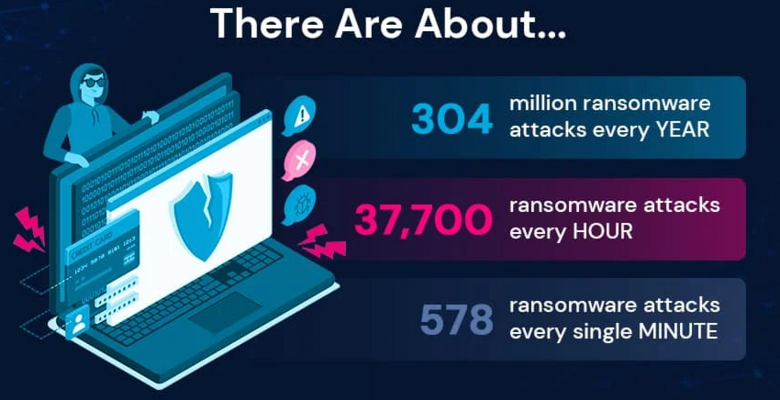Adding to the dismay comes an impending recession and ensuing global economic instability, which gives an ideal opportunity for cybercriminals to take advantage of the ill-prepared businesses seeking to cut expenses.
However, companies nowadays allocate the smallest annual budget for cybersecurity, according to a Security Priorities Study conducted by Foundry. Considering the already tight budgets and an impending recession, it is crucial for organizations to wake up to the idea of cybersecurity and explore ways to establish a robust security stance without spending too much money.
Everyone is at risk
Incidents such as Ransomware attacks, application data breaches, and phishing scams are becoming increasingly common, with hardly a day passing without a major news story about an organization falling victim. The truth is that everyone, from startups to Fortune 500 companies (irrespective of the industry) and CXOs to employees, is at risk of an attack.
By 2031, Cybersecurity Ventures forecasts that Ransomware attacks will take place every 2 seconds, a significant increase from every 11 seconds in 2021. Moreover, the financial toll of these attacks is expected to reach an alarming level by 2031.
The growing volume and sophistication of cyber-attacks, including but not limited to Ransomware, necessitate a heightened focus on cybersecurity. This makes the impending recession even more worrisome for businesses that are not currently equipped to handle such threats.
Dealing with cyber-attacks involves more than just prevention and immediate recovery efforts. The response process can extend over months or even years, as investigations are concluded and legal matters are resolved. It is in an organization's best interest to ensure they are adequately prepared for an impending attack, rather than regretting later.
Zero Trust to the rescue
Employing a robust Zero Trust architecture and AI-powered self-healing Ransomware response solutions, is essential for both preventing and responding to cyber threats in real-time. A robust Zero Trust Security Framework can monitor threats by identifying unusual activities throughout an organization's network, covering both endpoint devices and applications. In today's hybrid work environment, devices frequently connect from various locations beyond the office, inflating the attack surface.
By implementing a robust Zero Trust strategy, IT teams can be notified of abnormal activities across the entire network with the ability to remotely freeze or shut down devices/apps to stop a potential breach from infiltrating laterally.
However, it is imperative for the Zero Trust framework be 'robust' to maintain operational efficiency. Zero Trust shuts off devices as soon as any suspicious activity is detected helping to prevent breaches.
A robust Zero Trust approach operates on a contextual basis, analyzing each instance/feed of suspicious activity and notifies IT teams with secure access controls. For example, if an employee is on vacation in Italy and their device connects to the network from Italy, the device can remain online since the organization expects this activity.
When it comes to response solutions, self-healing and AI capabilities are vital for maintaining operations during serious cyberattacks. Self-healing technology enables the restoration and reinstallation of mission-critical applications to resume operations both during and post an attack. Self-healing AI-powered security solutions also aid in the recovery of endpoint devices, which are frequently left exposed and susceptible to reinfection after an attack.
Companies shall act now
Alarmingly, merely 23% of organizations have a formal cyber-security strategy in place. It is essential to understand that everyone is prone to cyber threats, and the primary focus should be on preparing for an attack, which involves both response and prevention.
Organizations ought to employ technology and staff training as elements of a prevention strategy, as detecting and thwarting cyber threats are the initial line of defense. In addition, readiness to respond is crucial in the event of a successful attack.
Being equipped to handle and recover from a Ransomware attack is particularly critical in industries like healthcare. If an organization lacks a plan to counteract an attack through a robust network, there may be delays or even data loss. This could result in slower response times for healthcare staff, leading to potentially grave consequences.
The need to prepare for and address cyber-threats is highly significant, but with an impending recession, it has become more crucial than ever.
Takeaway
To maintain a robust cybersecurity stance on a budget, companies can optimize their resources through upskilling and outsourcing. According to Cybersecurity Ventures, cybersecurity positions increased from 1 million in 2013 to 4 million in 2023, emphasizing a concerning shortage of cybersecurity professionals and an expanding skills gap. This number is expected to go insanely high in the coming years. Addressing this issue can be achieved by enhancing the skills of existing staff and IT teams through cybersecurity training, allowing them to better identify and report threats.
Various studies have repeatedly pointed to human error as the primary cause of data breaches, making it crucial for organizations to invest in cybersecurity awareness and training programs. Outsourcing security operations to a trusted managed cybersecurity services provider is another cost-effective approach to strengthen your security posture, particularly when in-house staff is already stretched thin. Yes! A managed security services provider will act as an extended arm for your existing IT/security team helping you to thwart off coming-of-age attacks.
By outsourcing, companies can save money on full-time dedicated staff while complementing internal staff training to control expenses. Although having dedicated cybersecurity teams is ideal, a combination of training and outsourcing offers an affordable alternative while maintaining top-notch cyber resilience.
Today, cybercriminals employ automation to accelerate their attacks and launch novel types of attack tactics at an unprecedented pace. To effectively counter these attacks, it is essential to integrate automation into your cybersecurity measures. A managed security services provider can help you deploy the right layers of cyber defense for your organization utilizing cutting-edge security platforms and tools that help to swiftly evaluate data, track unidentified risks and establish as well as implement a comprehensive line of defense throughout your organization’s network and IT architecture.

























